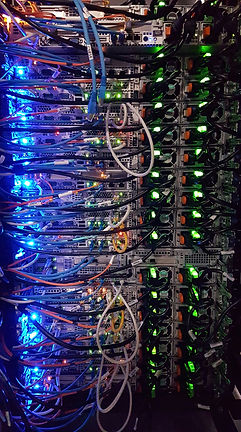

High-performance dual-socket Xeon processors along with Nvidia A6000 Ada Lovelace GPU powering intensive computational biology workflows.


🖥️⚡
High-Performance Workstations

🧑💻👩💻
Our lab hosts a robust suite of six high-performance workstations, designed to handle compute-intensive tasks with ease. Among them, two are powered by 5th Gen Intel Xeon dual-socket processors supporting 128 threads and equipped with 512 GB of DDR4 ECC RAM. One of these machines features a 48 GB NVIDIA RTX A6000 Ada Lovelace GPU with 32 TB of HDD storage and 1 TB SSD, housed in a powerful 2000W tower setup. The other includes a 20 GB NVIDIA A5000 Ada Lovelace GPU with an expanded 48 TB HDD and 1 TB SSD, all supported by a 1200W PSU. Another high-end system features a 2nd Gen Intel Xeon dual-socket 96-thread setup, 376 GB RAM, and a 24 GB NVIDIA RTX A5000 GPU with 24 TB HDD and 1 TB SSD. The remaining three systems also utilize 2nd Gen Intel Xeon dual-socket CPUs with 80 threads, 256 GB RAM, and 16 GB NVIDIA RTX A5000 GPUs, each offering 11 TB HDD with 1 TB SSD storage and 1200W PSUs. These machines form the computational backbone of our lab, ideal for demanding biological data analysis and established workflows.

Standalone workstations
Complementing our HPC infrastructure are eight standalone workstations built for versatile day-to-day analysis and development. Each workstation is powered by a 12th Gen Intel Core i9 processor, paired with 32 GB RAM and 2.5 TB of local storage. Every lab member is equipped with these standalone workstations along with a dual-monitor setup featuring two 27-inch high-resolution displays, greatly enhancing multitasking and visual analysis efficiency. These systems are optimal for sequence-structure analysis, scripting, visualization, web-based interfaces, and medium-scale computation, ensuring a seamless experience for all users. We also have six spare Intel i5 CPUs with six 19" monitors.
💻💲
Software and pipelines
The high-end configuration of our systems eliminates computational bottlenecks, enabling us to execute a wide variety of workflows entirely on-premises. All machines run on Linux-based operating systems, ensuring compatibility and performance across bioinformatics pipelines. From sequence alignment, clustering, and annotation, to structural predictions and dataset curation, nearly all operations are performed locally. We also maintain a growing collection of in-house tools, tailored to our research needs, which integrate seamlessly into our workflows and significantly accelerate project turnaround. Custom software and packages can be installed on demand, giving researchers unmatched flexibility and control.
🧠
Institutional High-Performance Computing Cluster
In addition to our in-house infrastructure, we have access to a powerful institutional High-Performance Computing (HPC) cluster that significantly extends our computational capabilities. The cluster comprises 50 dedicated nodes, purpose-built for parallel, high-throughput scientific workloads. Among them, 26 nodes are optimized for CPU-intensive tasks, featuring moderate RAM configurations ideal for large-scale sequence processing and alignment jobs. Eight high-memory CPU nodes are tailored for memory-heavy applications such as genome assembly, large matrix operations, or data-intensive analytics. For GPU-accelerated workflows, the cluster offers 10 NVIDIA A100 GPU nodes and 6 NVIDIA V100 GPU nodes, both of which are industry-leading solutions for deep learning, molecular modeling, and AI-driven biological predictions. This heterogeneous architecture allows us to distribute and execute tasks in parallel across multiple nodes, drastically reducing processing time and enabling scalable, reproducible research pipelines. The integration of this HPC resource into our workflows not only supports massive datasets but also empowers real-time iteration, prototyping, and discovery at a scale otherwise unattainable on local systems.

All lab members are provided with near-complete access to the entire hardware and software infrastructure, ensuring an empowered, efficient, and collaborative research environment.
